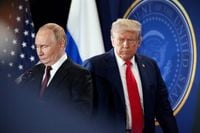Pressure is mounting on Ukraine as a controversial 28-point peace plan, brokered by the United States and heavily influenced by the Trump administration, takes center stage in the ongoing conflict with Russia. President Volodymyr Zelensky, facing what he describes as one of the most difficult moments in his country’s history, must now decide between “losing its dignity or losing a key partner,” a clear nod to the United States’ pivotal role in Ukraine’s fight for sovereignty. The plan, leaked to the public and widely debated, proposes a series of concessions that would dramatically reshape the Ukrainian state and test the resolve of its leadership and people.
According to BBC, the plan requires Ukraine to hand over territory not currently occupied by Russia, while allowing Moscow to retain control over vast swathes of Ukrainian land it has already seized, including Crimea, Donetsk, and Luhansk. The proposal also mandates that Ukraine hold elections within 100 days—a logistical nightmare in the midst of war—and significantly reduce its military capabilities while abandoning any aspirations of joining NATO. These terms have been described by security analysts as putting Ukraine in an “impossible situation.”
Russian President Vladimir Putin has enthusiastically endorsed the plan, stating it could serve as the “basis of a final peace settlement.” The timing of this endorsement is no coincidence. As CNN reports, Russian forces are on the verge of capturing the strategic eastern hub of Pokrovsk and have made alarming advances near Zaporizhzhia city. Ukraine, meanwhile, is grappling with high rates of desertion and draft avoidance, compounded by a domestic political crisis involving a corruption scandal that has eroded President Zelensky’s popularity and sapped public morale.
The peace plan’s origins and content have raised eyebrows among diplomats and analysts alike. CNN notes that much of the text mirrors Russia’s maximalist demands from failed negotiations in Istanbul in 2022, when its military ambitions were at their peak. The plan demands that Ukraine constitutionally renounce NATO membership, “de-Nazify,” guarantee its neutrality, and limit the size of its armed forces—terms that, in effect, amount to a form of surrender. These demands are not new, but their reappearance at a moment of Ukrainian vulnerability has led some European diplomats to liken the situation to “Groundhog Day,” a cycle of repeated, fruitless negotiations that only serve to buy time for Moscow’s military advances.
Adding to the controversy are the plan’s provisions for Ukraine’s postwar reconstruction. It proposes using $100 billion in frozen Russian funds to rebuild Ukraine, but with a twist: Russia would oversee the reconstruction in occupied territories, and half the profits would go to the United States, with additional investments in joint US-Russian projects. International sanctions on Russia would be lifted entirely, a move that would hand Moscow a massive financial windfall. The scope for Russia to recoup much of this money is vast, raising concerns among Western observers about the true intent behind these economic incentives.
One of the most contentious aspects of the peace plan is its call for elections within 100 days of signing. Experts argue that such a timeline is technically impossible given the challenges of demobilizing troops, ensuring security, and reforming wartime legal structures. A rushed election could lead to a government with questionable legitimacy, opening the door to manipulation and further instability. As CNN points out, this deadline is not just impractical—it is a strategic ploy that could undermine Zelensky’s leadership at a time when he is already facing internal dissent.
The plan also suggests turning parts of the eastern Donbas region still under Ukrainian control into a demilitarized zone that would technically be part of Russia. This would effectively surrender these territories without a fight and create a buffer for future Russian advances. The vague language of the deal, including “snapback” clauses that could invalidate security guarantees if Ukraine were to attack Russian cities “without cause,” further complicates the picture. The requirement for Ukraine to reject all “Nazi ideology and activities” echoes Russian propaganda and could be used as a pretext to void the agreement at Moscow’s discretion.
The Center for Strategic and International Studies (CSIS) has weighed in on the prospects of Trump’s peace plan, noting that its success hinges on whether it serves as a starting point for broader negotiations rather than an end in itself. According to CSIS, peace deals often fail due to commitment problems—neither side can trust the other not to use a pause in fighting to regroup and launch future attacks. Russia’s history of breaking agreements, such as the Minsk I and II protocols, only deepens Ukrainian skepticism. “Ukraine can survive not being in NATO,” CSIS analysts argue, “but it cannot survive as a sovereign state with a hollowed-out military and limits on the ability of European states to deter future Russian aggression.”
There are, however, elements of the plan that experts see as potentially constructive. The economic proposals—such as large-scale Western investment in Ukrainian infrastructure and the use of Ukraine’s gas transit network for European energy—are viewed as highly negotiable and mutually beneficial. AI models and human experts alike rate the humanitarian aspects of the plan, particularly the return of deported Ukrainians and children, very positively. Yet, these positive elements are overshadowed by the plan’s more problematic provisions, especially those related to territory, military restrictions, and blanket amnesty for war crimes.
CSIS warns that the plan’s requirement for Ukraine to recognize Russian control over occupied territories and cap its armed forces would be politically impossible for Kyiv to accept voluntarily. These terms, coupled with the plan’s limited security guarantees and amnesty for all parties, create a recipe for renewed violence and instability. The plan’s justice and governance provisions run counter to expert expectations for a sustainable settlement, particularly the strong desire in Ukraine and Europe for accountability for Russian war crimes.
With a deadline set by Trump for Thursday, November 27, 2025, Ukraine is under immense pressure to respond. Zelensky has indicated that his government is preparing its own peace proposal, but time is running short. The stakes could hardly be higher: accept a deal that risks undermining Ukraine’s sovereignty and democracy, or face the prospect of losing critical Western support at a moment of acute military and political vulnerability.
As the world watches, the fate of Ukraine hangs in the balance. The choices made in the coming days will not only determine the country’s future, but could also reshape the security architecture of Europe for years to come.






